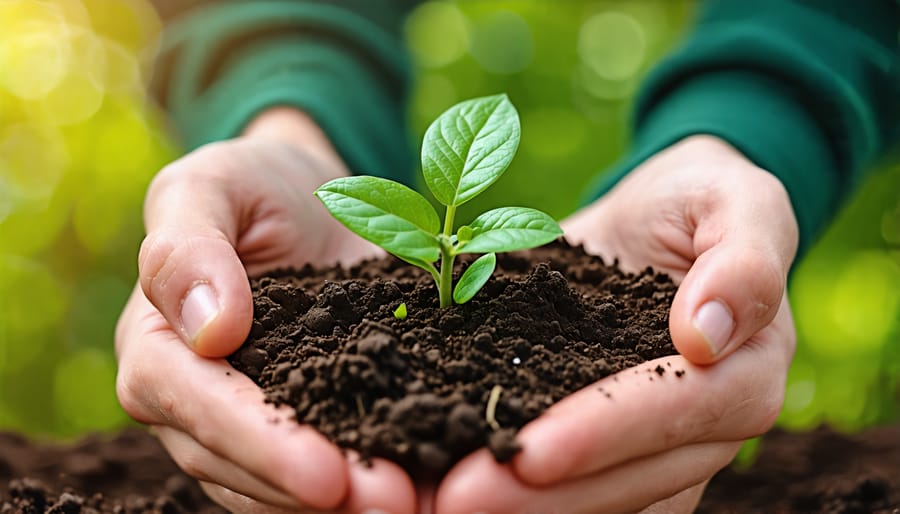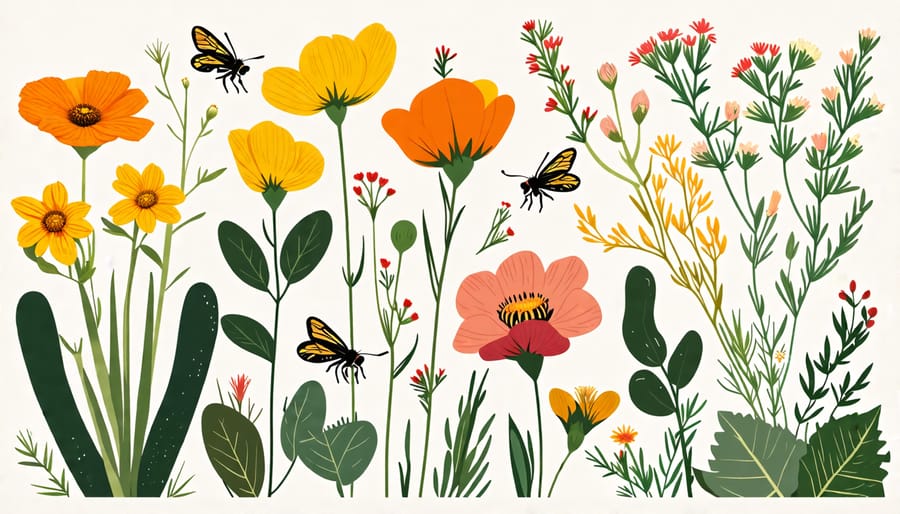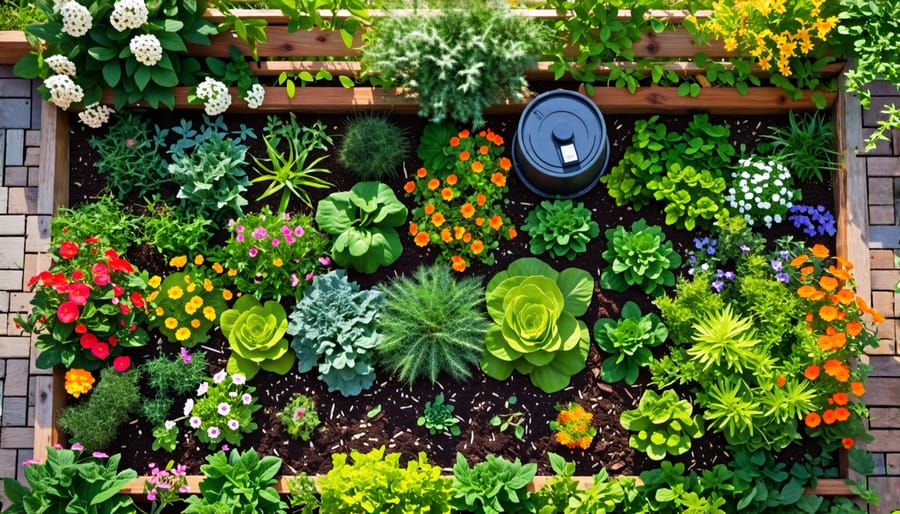Choose a sunny spot with well-draining soil for your sustainable garden. Clever shed ideas can help you organize your tools and supplies. Enrich the soil with organic compost to promote healthy plant growth. Plant a diverse mix of native species, companion plants, and nitrogen-fixers to create a resilient ecosystem. Mulch heavily to retain moisture, suppress weeds, and regulate soil temperature. Install a rainwater harvesting system to conserve water and reduce your environmental impact. Embrace natural pest control methods like companion planting, handpicking, and encouraging beneficial insects to maintain a chemical-free garden.
Choose the Right Location

Assessing Sunlight
To assess sunlight in your yard, start by observing different areas throughout the day. Most vegetables and fruits require at least six hours of direct sunlight daily. Using a sunlight calculator or shade analysis tool can help you determine the amount and intensity of light each spot receives. Consider factors like seasonal changes, shade from buildings or trees, and sun patterns that shift during the year. Keep a journal to track sunlight duration in potential garden locations over time. This data will guide you in selecting the optimal site for your sustainable garden, ensuring your plants receive the right balance of light to thrive.
Proximity to Water Source
Having a nearby water source is crucial for sustainable gardening success. Ideally, your garden should be located close to a spigot or hose for easy watering access. This proximity not only saves time and effort but also conserves water by minimizing evaporation and runoff during transport. If your chosen location lacks a convenient water supply, consider installing a rain barrel or drip irrigation system fed by a nearby water source. These eco-friendly solutions can help you efficiently deliver water directly to your plants’ roots, reducing water waste and promoting healthier growth. For those without a viable outdoor water source, try collecting greywater from household activities like washing vegetables or cooking pasta. This recycled water is suitable for many plants and can significantly reduce your reliance on municipal water supplies. By prioritizing proximity to water and exploring alternative sources, you’ll be well-equipped to keep your sustainable garden thriving while minimizing your environmental impact.

Build Healthy Soil
Creating nutrient-rich soil is the foundation of a thriving sustainable garden. One effective technique is composting, which involves breaking down organic matter like food scraps and yard waste into a dark, crumbly substance packed with beneficial microorganisms. This compost can then be mixed into your garden beds to improve soil structure and fertility. Mulching is another key practice, where you cover the soil surface with organic materials such as straw, leaves, or wood chips. Mulch helps retain moisture, suppress weeds, and regulate soil temperature while slowly decomposing to add nutrients over time.
Cover crops, also known as green manures, are plants grown specifically to be tilled back into the soil. They help prevent erosion, fix nitrogen, and add organic matter when chopped down and incorporated into the earth. Some popular cover crops include clover, rye, and peas. Crop rotation, or alternating the location of different plant families each season, can also help maintain soil health by preventing nutrient depletion and reducing pest and disease buildup.
Lastly, consider using sustainable garden sheds to store your tools and supplies without harming the environment. By implementing these soil-building techniques consistently, you’ll create a robust foundation for your sustainable garden to flourish season after season. Remember, healthy soil is the key to growing vibrant, productive plants while minimizing the need for synthetic fertilizers and pesticides.
Select Sustainable Plants
When selecting plants for your sustainable garden, opt for species that are well-adapted to your local climate. Native plants are an excellent choice as they have evolved to thrive in your area’s specific conditions, requiring less water, fertilizer, and pest control. You can find information on native plants through local gardening clubs, nurseries, or online resources like the National Wildlife Federation’s Native Plant Finder.
Drought-tolerant plants are another smart selection for eco-friendly gardens, especially in regions prone to dry spells or with water usage restrictions. These resilient plants have deep root systems and unique leaf structures that help them conserve moisture and withstand periods of limited rainfall. Succulents, cacti, and many Mediterranean herbs like lavender and rosemary are examples of drought-tolerant options that add beauty and functionality to your garden.
Don’t forget to include plants that attract pollinators such as bees, butterflies, and hummingbirds. These beneficial creatures play a vital role in ecosystem health and food production. Choose a variety of flowering plants with different bloom times to provide a consistent nectar and pollen source throughout the growing season. Some pollinator-friendly favorites include coneflowers, milkweed, salvia, and zinnia. You can even dedicate a section of your garden to a pollinator habitat, which can double as a charming feature to enjoy from vinyl storage sheds or seating areas.
By selecting sustainable plants suited to your climate and local ecosystem, you’ll create a thriving, low-maintenance garden that supports biodiversity and conserves resources.

Water Wisely
Conserving water is essential for sustainable gardening, and there are several strategies you can employ to minimize water usage while keeping your plants healthy and thriving. One effective method is drip irrigation, which delivers water directly to the roots of your plants, reducing evaporation and ensuring that water is used efficiently. Setting up a drip irrigation system is relatively simple and can save you time and money in the long run.
Another key strategy is to water your plants deeply and infrequently, rather than providing shallow, frequent watering. This encourages deeper root growth, making your plants more resilient to drought and extreme weather conditions. When watering, aim to moisten the soil to a depth of 6-8 inches, and then allow the soil to dry out slightly before watering again. You can also use a moisture meter or simply stick your finger into the soil to check if it’s time to water.
Harvesting rainwater is another eco-friendly way to reduce your reliance on tap water for your garden. By installing a rain barrel or a more complex rainwater harvesting system, you can collect and store rainwater for later use in your garden. This not only saves water but also provides your plants with nutrient-rich water that is free from chlorine and other chemicals found in tap water.
Mulching your garden beds is another effective way to conserve water. Organic mulches, such as straw, wood chips, or shredded leaves, help retain moisture in the soil, reduce evaporation, and suppress weed growth. As the mulch breaks down, it also adds organic matter to the soil, improving its structure and water-holding capacity.
Finally, consider incorporating drought-tolerant plants into your garden design. Many beautiful and low-maintenance plants, such as succulents, lavender, and California poppies, thrive in dry conditions and require minimal watering once established. You can also use greenhouses to create controlled environments that optimize water usage and protect your plants from extreme weather conditions.
Control Pests Naturally
When it comes to managing pests in your sustainable garden, opt for earth-friendly methods that promote a healthy ecosystem. Companion planting is a fantastic strategy that involves placing certain plants together to deter pests naturally. For example, planting marigolds near tomatoes can help repel whiteflies and aphids. Handpicking insects off your plants is another effective way to control pest populations without resorting to harsh chemicals. Regularly inspect your plants for signs of damage and remove any visible pests, such as caterpillars or slugs. Encourage beneficial predators like ladybugs, lacewings, and praying mantises to take up residence in your garden by providing them with a diverse habitat. These helpful insects feed on common garden pests, keeping their numbers in check. You can also create homemade pest deterrents using natural ingredients like garlic, hot peppers, or neem oil. By embracing these eco-friendly pest control methods, you’ll create a thriving, sustainable garden that works in harmony with nature.
Harvest and Enjoy
When it comes to harvesting your sustainable garden, timing is key for optimal flavor and nutrition. Keep a close eye on your plants and pick vegetables and fruits at their peak ripeness. For most crops, this means harvesting in the morning after the dew has dried but before the heat of the day sets in. Gently remove produce from plants using clean, sharp tools to avoid damage.
Handle your harvest with care to minimize bruising and extend shelf life. Rinse off any dirt, then store vegetables and fruits properly based on their specific needs – some may require refrigeration while others do best at room temperature. Enjoy your fresh, sustainably grown produce right away for maximum taste and health benefits, or preserve some of your bounty by freezing, canning, or dehydrating for year-round enjoyment. Remember to compost any trimmings to nourish your soil for the next growing season.
Conclusion
Starting a sustainable garden is a rewarding and enjoyable way to make a positive impact on the environment while reaping the benefits of fresh, homegrown produce. By following the 7 simple steps outlined in this guide, you’ll be well on your way to creating a thriving, eco-friendly garden. Remember to choose the right location, build healthy soil, select plants wisely, use water efficiently, embrace natural pest control, compost, and enjoy your harvest. With a little planning and dedication, anyone can become a successful sustainable gardener. So what are you waiting for? Roll up your sleeves, get your hands dirty, and embark on your sustainable gardening journey today!





Leave a Reply